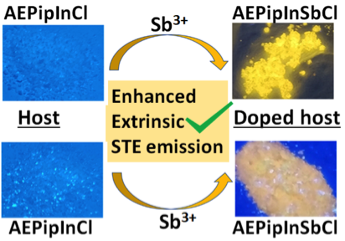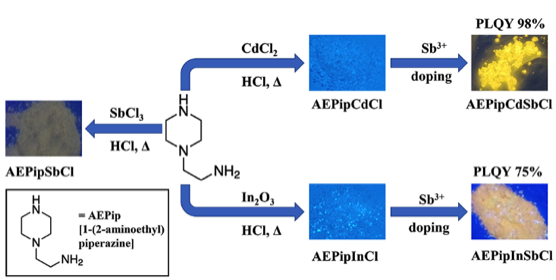REPORT FOR PMR FELLOWSHIP FROM OCTOBER 2021 - MARCH 2023

Deep Kumar Das
Title: Intrinsic vs. extrinsic STE emission enhancement in ns2 ion doped metal (Cd, In) halide hybrids
Executive Summary
Broadband emission in zero-dimensional metal (Sb3+, In3+, Cd2+, and Bi3+) halide hybrids originates from self-trapping of excitons within the metal-halide units (intrinsic STEs). Regulation of intrinsic STE emission can be affected by introducing extrinsic ns2 ion based dopants. Recently, Sb3+ doping of a Cd halide host system (Rb4CdCl6) has been claimed to enhance host intrinsic STE emission through lattice softening (stereochemical activity of dopant ions). However, the similarity of photo-physical properties of Cd host (intrinsic STE) and Sb3+ dopant (extrinsic STE) emission precludes a clear understanding of the origin/nature of the enhanced emission (intrinsic vs. extrinsic STEs). Reported herein is the synthesis and characterization of ns2 ion doped Cd and In-based metal halide hybrids [(C6H18N3)2 (In0.7Sb0.3Cl6)2.2(H2O) abbreviated as AEPipInSbCl and (H3O)(C6H18N3)3 (Cd0.94Sb0.06Cl6)2.2Cl.2(H2O) abbreviated as AEPipCdSbCl] that show enhanced and efficient broadband emission. Detailed optical characterization of doped Cd and In host systems conclusively asserts that the enhanced emission originates from dopant extrinsic STE emission and not from host intrinsic STE emission. Furthermore, the observed dependence of emission PLQY on doping efficiency clearly supports dopant based extrinsic STE as the origin/nature of enhanced emission. A maximum PLQY of 98% (near unity) was achieved for 5% Sb3+ doping in the AEPipCdCl system. Strong excitation dependent emission in host systems (in contrast to excitation independent emission in doped systems) allows clear distinction between host intrinsic and dopant extrinsic STE emission thereby providing insight to the operative emission mechanism. This work highlights the role of dopants in shaping the emission profile and provides a requisite understanding of the mechanism of enhancement of extrinsic dopant STE emission.


External Teaching Assistantships:
Polymer Chemistry (at Sri Venkateshwara College of Engineering, Tirupati)
Achievements:
Best poster award at “INTERNATIONAL CONFERENCE ON FUNCTIONAL MATERIALS FOR ADVANCED TECHNOLOGY – 1”
Publications:
- Intrinsic vs. extrinsic STE emission enhancement in ns2 ion doped metal (Cd, In) halide hybrids
- K. Das, R. Bakthavatsalam, V. R. Hathwar, R. Pallepogu, J. Kundu, J. Mater. Chem. C. 2023, 11, 3855-3864
- Mn2+-activated zero dimensional metal (Cd, Zn) halide hybrids with near unity PLQY and zero thermal quenching
- H. Marayathungal, D. K. Das, R. Bakthavatsalam, J. Sam, V. R. Hathwar, R. Pallepogu, S. Dutta, J. Kundu, Journal of Physical Chemistry C (Accepted)



